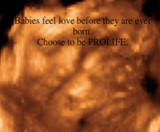All her physical characteristics are decided at the moment of conception.
Some people say she's not a person.
She has her own unique fingerprints 14 days after conception.
Some people say she's not a person.
Her heart begins to beat 18 days after conception.
Some people say she's not a person.
She starts to respond to sound and duck away from strong light as early as 16 weeks.
Some people say she's not a person.
She is able to swallow, yawn, and suck on her fingers by 18 weeks.
Some people say she's not a person.
When she sees light, she follows it with her hands as early as 20 weeks.
Some people say she's not a person.
She comes to know her mother's voice and even change the pattern of her finger-sucking in order to activate her mother's voice around 25 weeks.
Some people say she's not a person.
She recognizes nursery rhymes and music around 33 weeks.
Some people say she's not a person.
When she is born, she calms down when she hears the music from TV shows that her mother watched during pregnancy.
Some people say she's not a person.
She is a fully-functioning human being by 38 weeks.
And yet some people say she's not a person.
Wednesday, June 17, 2009
Some People Say She's Not A Person
Posted by Protecting Birth at 12:34 PM 0 comments
Monday, June 15, 2009
No human is a Non human(abortion is wrong)
here are essentially two issues which must be resolved concerning unborn embryos and fetuses. The first is, "Are they human beings?" The second is, "Should they be recognized as persons under the law?" We've already established that there is no debate on the first question. It is a matter of plain, objective science. Embryos and fetuses are fully and individually human from the moment of fertilization on. If this were not true, if unborn children were not genetically-distinct human beings, there would be no need to even talk about rights of personhood. "Removing a fetus" would be the moral equivalent of pulling a tooth. This, however, is not the case, and so the debate must now enter the political arena.
So should humans be recognized as persons under the law? Yes, because humans are persons. Something is a person if it has a personal nature.1 In other words, something is a person if, by nature, it has the capacity to develop the ability to think rationally, express emotion, make decisions, etc. This capacity is something that a person has as soon as he begins to exist, since it is part of his nature (in other words, if he exists, he has it). Since humans have a personal nature, humans are persons. As for the fetus, since it is a human (and so, something with a personal nature), it is a person.2 Just as a cat qualifies as a feline simply by being a cat, a fetus qualifies as a person simply by being a human.3 So, it is impossible for a fetus to not be a person.
This fact should be enough. The intrinsic humanity of unborn children qualifies them as persons and should, therefore, guarantee their protection under the law. For more than thirty-five years, however, this has not been the case in America. The situation we are left with is this. There is a huge and singular group of living human beings who have no protection under the law and are being killed en masse every day. Is that not astounding?! It is astounding, but not wholly unprecedented.
There have been at least two other instances in American history in which specific groups of human beings were stripped of their rights of personhood as a means of justifying horrific mistreatment. African-Americans and Native-Americans both felt the brunt of a system which tried to create the artificial classification: human, non-person. This distinction wasn't based on an honest evaluation of the evidence, but with an eye towards justifying a specific action. In the case of Native-Americans, they had land. In the case of African-Americans, they had labor. Classifying them as non-persons (even property) provided a moral framework for those in power to forcefully take what they wanted without compensation. Today, "unwanted", unborn children don't hold anything as tangible as land or labor, but their claims on those who would eliminate them are no less significant. They stand in the way of an unencumbered, more self-absorbed lifestyle. Once again this notion that human beings can be classified as "non-persons" is not built on an objective assessment of the facts, but with an eye towards justifying abortion.
At this point, some people define the term ‘person’ according to function (call this view the functional view of persons). That is, they say that something qualifies as a person if it can do certain things, like think rationally. But this definition of personhood fails. First, there are clear cases in which something qualifies as a person, but cannot do the things required of the functional view of persons.4 For example, a human person under a general anesthesia does not qualify as a person under the functional view of persons, since a person in this situation does not have the ability to think rationally. Two, the functional view of persons does not fit certain intuitions about persons. For example, if you had a cat that couldn’t purr, couldn’t chase mice, and couldn’t climb trees, you wouldn’t say that your cat isn’t a feline (though you should if you define ‘feline’ in terms of function). Instead, you would say that your cat is a cat that can’t purr, chase mice, or climb trees.5 In the same way, if you know a human that can’t think rationally (like a fetus, or a person under a general anesthesia), you shouldn’t say that this human isn’t a person, but that this is a person who (at the moment) can’t think rationally. In light of these reasons, the functional view of persons should be rejected.
Even though we do not qualify or disqualify something as a person on the basis of what it can or can’t do, it’s still worth noting that fetuses display aspects of their personal nature while still in the womb. That is, fetuses can do things that you would only expect of more fully developed persons. For example, National Geographic, in their video, In the Womb: Multiples, goes so far as to say, "As identical twins grow bigger, they're almost always in contact, touching hands, faces, feet and gradually becoming more aware of themselves and each other." Did you catch that? They're becoming more and more aware of themselves and each other. Developing human beings begin responding to and interacting with their environment long before they are born. The following testimony should help make that abundantly clear:
Posted by Protecting Birth at 8:28 AM 0 comments
Sunday, June 14, 2009
Hey there!
Hello,
Welcome to the site! We are currently working on getting everything in line. But I hope you will hang on to see what we have to share.
Our Goal:
To show that Birth is a natural part of Life,
That woman have the right to choose where they want to have THEIR baby,
To help Allow Midwifes in all 50 states,
To be able to have a Vaginal birth after having a C-section
To be able to have a Homebirth in any state
You can help us make a difference.
Thank you.
Posted by Protecting Birth at 1:23 PM 0 comments










